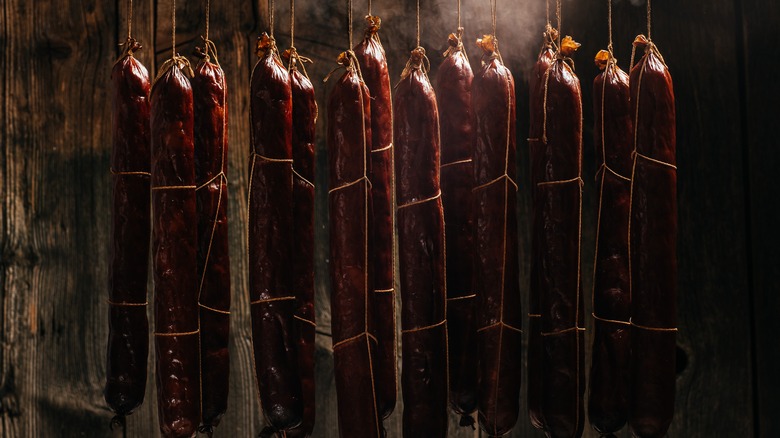Old World Pepperoni Is All About European Flavor Traditions
Charcuterie enthusiasts and pizza lovers know all pepperoni isn't alike. While they all share a rich savoriness and subtle spice, old world pepperoni is a distinctive style that showcases the unique way foods evolve around the globe.
It may come as a shock to many, but pepperoni actually has its roots here in America, not back in Italy, like similar cured meats like salami or soppressata. This surprising origin of pepperoni stems from inventive Italian-American immigrants, who adapted traditional recipes to the ingredients and tastes of their new home by adding hot peppers and paprika to salami-style sausages. However, two divergent styles of the cured meat emerged. One used modernized food production processes, while the other relied on more traditional techniques. The latter has come to be known as Old World pepperoni.
Old World pepperoni earns its name through the use of European-style fermenting. This includes not only lactic acid-producing strains (which is also used in the American style) but a distinctive variety known as coagulase-negative cocci or CNC. They feed on and transform the pork and other ingredients. This process helps preserve the pepperoni and also introduces the bold and complex flavors that are a hallmark of the style. It also creates a darker, richer color that contrasts beautifully with the cheese on a pizza.
Telltale signs of Old World craftsmanship
Another distinguishing characteristic of Old World pepperoni is its casing. Old World recipes use traditional ones made from cleaned animal intestines, known for their ability to stretch and their contribution to the fermentation process. Meanwhile, American-style pepperoni uses an artificial casing or no casing at all.
This American style is the type most average people are familiar with. Instead of the mix of bacteria used in Old World, this version uses a more narrow lactic acid blend that results in a milder flavor. It's also generally larger, softer, and sliced more thinly. This allows it to lie flat on pizza, as opposed to the cupping of Old World style, which some prefer.
While it's called Old World pepperoni, don't expect to dine on a pepperoni pizza in Italy. While the country does have an ingredient called peperone, it's different from the styles of pepperoni you're used to. Peperone translates to roasted bell peppers. Instead, you could try ordering a pizza with salamino piccante, which is the closest you can get to the ingredient while in Italy.

